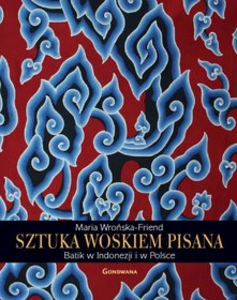Art Drawn with Wax: batik in Indonesia and Poland
Wrońska-Friend, Maria (2008) Art Drawn with Wax: batik in Indonesia and Poland. Gondwana Publishing, Warszawa, Poland, pp. 1-256.
![[img]](https://researchonline.jcu.edu.au/7296/1.hassmallThumbnailVersion/7296_Friend_2008_cover.jpg)
|
Image (JPEG) (Front Cover)
- Cover Image
Download (29kB) |
|
|
PDF (Front Pages)
- Supplemental Material
Download (5MB) |
||
|
PDF (Back Pages)
- Supplemental Material
Download (22kB) |
Abstract
This book by Dr Maria Wrońska-Friend, Art Drawn with Wax: Batik in Indonesia and Poland is an important and long-awaited publication. It fills a major gap in textile studies by presenting, for the first time ever, both past and recent Polish accomplishments with batik technique, while at the same time situating the textile art of our country in an international context. Dr Wrońska-Friend considers the adaptation of the Javanese decorative method into Polish arts to be one of the most interesting examples of the cross-cultural transfer of the batik technique to Europe. She believes that Polish batiks, together with Dutch batiks, should be recognized not only as an artistic but also as a technical advancement of this method of textile decoration. Polish artists significantly expanded the vocabulary of batik designs and, as a result of numerous successful experiments conducted with new plant dyes, they were able to increase greatly the range of colors and hues available.
The author’s research commences at the beginnings of the twentieth century, when Polish artists became fascinated both with the original Javanese batik textiles and their ‘exotic beauty’ as well as with the technique of ‘drawing with wax’, introducing it to their fabric decoration. Batik technique was first introduced into European arts in the late nineteenth century by Dutch artists, and quickly found followers all over Europe, including Poland. The peak of popularity of this technique in our country came in the first quarter of the twentieth century. In recent years, batik has once again become popular among Polish artists and the last section of the book documents this new artistic trend.
The issue of the similarities and differences between Javanese batik textiles and their European interpretations, including Polish ones, became a topic of interest for the author many years ago, well before she began to write this book. Maria Wrońska-Friend presented the outcomes of her research as an outstanding PhD thesis at the Institute of Arts of the Polish Academy of Sciences in Warsaw in 1987. Following graduation from the Department of Ethnology at the University of Lodz and employment as a curator at the Asia and Pacific Museum in Warsaw (an institution which among its significant Indonesian collections had a large group of Javanese batiks), she was well prepared to undertake this pioneering, ambitious research.
| Item ID: | 7296 |
|---|---|
| Item Type: | Book (Research - A1) |
| ISBN: | 978-83-920366-4-7 |
| Keywords: | textiles; cross-cultural connections; Indonesia; Poland |
| Additional Information: | Original title: Sztuka woskiem pisana. Batik w Indonezji i w Polsce. Polish summary: Batik - jawajska technika barwienia tkanin z zastosowaniem osłony z płynnego wosku, około 1920 r. zdobyła w Polsce ogromną popularność. Batiki wykonywali zarówno zawodowi artyści, wśród nich członkowie stowarzyszenia Warsztaty Krakowskie, jak i rzesze amatorów. Dogłębne studia batikowanych tkanin przywiezionych z Indonezji przez polskich przyrodników (Marian Raciborski, Michał Siedlecki) jak i podobna kolekcja w zbiorach Feliksa "Mangghi" Jasieńskiego, przyczyniły się do przeniesienia elementów jawajskiej estetyki, techniki i technologii barwienia do sztuki polskiej. Wynikiem tego był swoisty styl dekoracyjny, często określany jako jawajsko-krakowski. W ostatnich latach działalność Akademii Łucznica przyczyniła sie do renesansu tej techniki. Współczesny batik polski to dynamicznie rozwijająca się dziedzina malarstwa woskiem uprawiana przez kilkudziesięciu artystów, nauczana w wielu ośrodkach szkolenia plastycznego i coraz częściej wprowadzana do programów wyższych uczelni. Przedstawiona praca jest wynikiem wieloletnich badań autorki na wyspach Indonezji, jak również analizy kolekcji tkanin w zbiorach wielu muzeów polskich. Książkę ilustrują najwspanialsze przykłady batików jawajskich z kolekcji Rudolfa G. Smenda z Kolonii, uznawanej za jeden z najbardziej znaczących zbiorów tych tkanin na świecie. Przykłady batików polskich pochodzą z kolekcji Muzeów Narodowych w Krakowie i Warszawie, Muzeum Etnograficznego w Krakowie oraz zbiorów prywatnych. |
| Date Deposited: | 23 Jun 2010 23:06 |
| FoR Codes: | 19 STUDIES IN CREATIVE ARTS AND WRITING > 1901 Art Theory and Criticism > 190199 Art Theory and Criticism not elsewhere classified @ 100% |
| SEO Codes: | 95 CULTURAL UNDERSTANDING > 9502 Communication > 950201 Communication Across Languages and Culture @ 51% 95 CULTURAL UNDERSTANDING > 9501 Arts and Leisure > 950199 Arts and Leisure not elsewhere classified @ 49% |
| Downloads: |
Total: 663 Last 12 Months: 22 |
| More Statistics |



